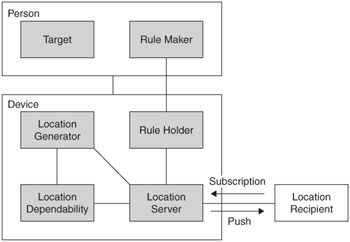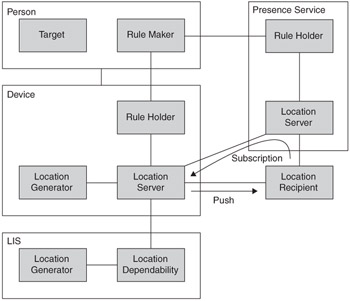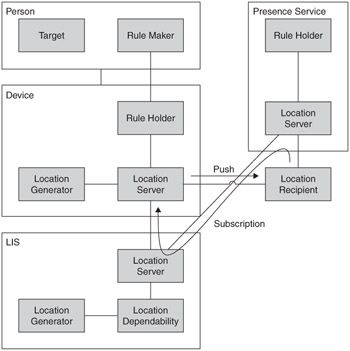Autonomous Location Determination
A device can determine its own location in a number of ways. One of the simplest, and sometimes overlooked, possibilities is to ask the user of the device where they are. A manually provided location can sometimes be more accurate and precise than other options-in fact, it is particularly useful for civic addresses. A number of the technologies described in this book can also be used by a device to determine its location without assistance from the LIS.
There is also the question of why a device would need to establish a LIS relationship at all. Of course, it does not have to-it is the user of, or using application on, the device which determines what will make the decision to utilize a LIS. Application and users may require features that only the LIS is able to provide. This section describes autonomous location determination and explores instances where a LIS can still add value. Using the LIS in this way also decouples application requirements from device capability such that per-application semantics are not required to take advantage of device self-location capability. The LIS is able to ensure that a consistent set of features is always available for all applications, and common location reference semantics are used regardless of whether the device is involved or not.
Device Independence
It is possible that a device could provide all of the features necessary for location so that it did not need any assistance from a LIS. A fully independent device is capable of determining its own location from measurements that it can obtain. This device is also responsible for providing location information to location users, which could include serving a location URI and subscriptions for location information. Figure 9.1 shows the logical roles in this configuration.

Figure 9.1: Device roles in completely independent operation.
The device in this scenario can either push location information to recipients (by-value) or it can serve subscriptions by providing a location URI (by-reference). The device can publish a location reference by using some application-specific protocol, or by emulating a LIS by supporting the server side of HELD.
A presence service can be employed by the device, providing that the device is able to generate sufficient notifications, or serve a subscription. The presence service can provide a layer of protection for the device by compositing all subscriptions into a single session and by authenticating all location recipients. Figure 9.2 shows that the location server role is taken by both the device and presence service.

Figure 9.2: An independent device is able to use a presence service to simplify its role.
This configuration allows the device to push location directly to the location recipient (location by-value), or to service subscriptions that are directed through the presence server (location by-reference). The presence server enforces the authorization policy for location subscriptions, ensuring that the device does not have to manage this complexity.
These configurations require that the device is able to digitally sign location information if an application requires dependable location. This implies that the digital signature has to be adequately trusted by the users of the location information. This may not be feasible for location users since the complexity of managing trust relationships with individuals is greater than managing trust with a smaller group of access network providers. This is especially true for applications that do not have prearranged arrangements with their users. For instance, emergency services care about the integrity of location information but will not undertake to establish a trust relationship with every potential user.
The LIS Provides Credentialed Location
The LIS, due to its authoritative position in an access network, is well suited to providing credentialed location information. By using the assertion mechanism provided in HELD, the device can generate location information and provide this in a message to the LIS that requests a signed PIDF-LO. The device is then able to operate independently for most functions, only using the LIS when credentialed location information is required for a particular application. Figure 9.3 shows the allocation of roles in this arrangement.

Figure 9.3: Delegating the responsibility for credentialed location to the LIS.
The LIS needs to be able to check location information before it can certify that it is accurate. A second location generator at the LIS is included so that the LIS can check the location information provided by the device against a location that is generated by a trusted source.
A LIS-Provided Location URI
Access network configurations sometimes prevent network users from creating their own services. This is often because a firewall or Network Address Translation (NAT) device is deployed to improve network security or for address management. This prevents a device from creating a publicly accessible location URI.
The LIS within that network is able to provide a publicly accessible location URI. The device requests that the LIS provide a location URI by creating a context on the LIS. The device then ensures that all requests are forwarded to it by indicating a capability to determine its own location. The LIS will then forward all requests through to the device. Figure 9.4 shows how this might be achieved.

Figure 9.4: The LIS can be used to provide publicly accessible location URIs.
This is, to a large extent, the same method that is used by SIP proxies to ensure that SIP URIs are reachable. In comparison, this configuration is more complex than a direct proxy arrangement. The LIS is now directly in the request path, therefore it assumes some responsibility for the accuracy of the location information. The LIS validates location information against the location that comes from its own location generator to protect against fraud.
The LIS is also able to use its location determination capacity to serve requests where appropriate, only contacting the device when necessary.
EAN: 2147483647
Pages: 129